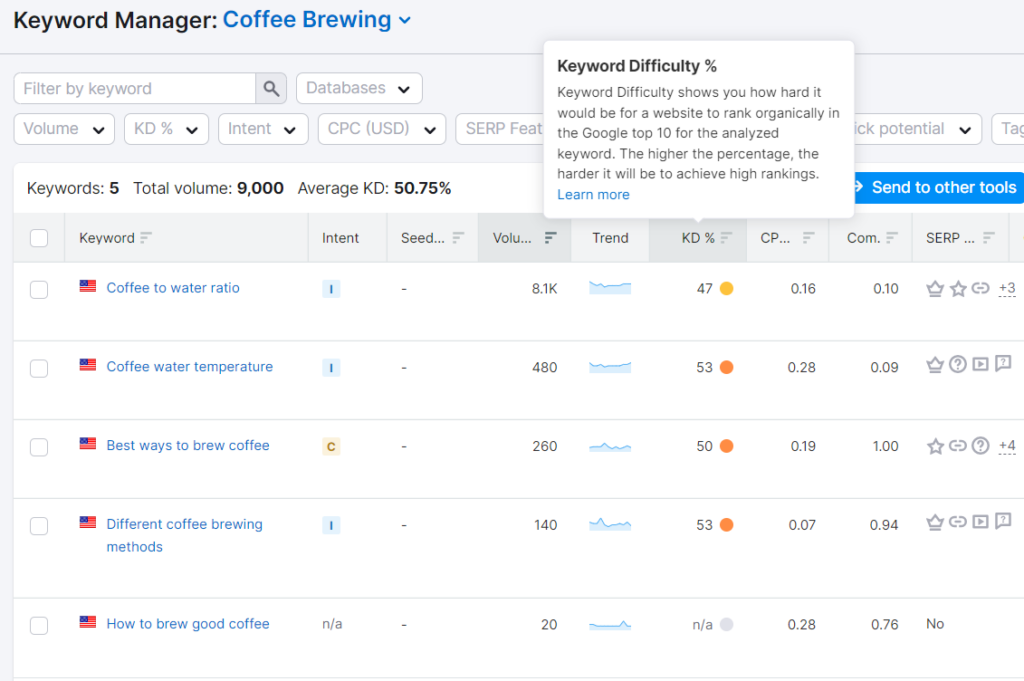SEO & Finding Your Brand’s Keywords, Part 1
Selecting your brand’s keywords and creating a successful content marketing strategy is important no matter the size of your brand. Including the right keywords in your content is critical to compete in the SERPs (search engine results pages). With 75% of shoppers saying they use search early in the purchase process, can you really afford not to invest in finding the right keywords?
Search engines like Google are constantly updating their algorithms. Maintaining a set of strong keywords for your brand requires making ongoing optimizations. In this post, I am going to lay out how you can quickly build a list of relevant keywords for your brand to kick off your SEO (Search Engine Optimization) strategy. Next week, I’ll be back to share some guidance on where you can start leveraging your brand’s keywords to improve rankings once you have created this list.
It may seem like a lot, but the right SEO can have a great impact on your digital presence, and the right media partner can help you put it all together as part of your overarching marketing strategy.
Step 1: Establishing Topics
Keywords are used by search engines to help match relevant searches on their platform with content on a website. This means the topics and keywords you’re attaching to your content strategy should factor in the intent behind what people are asking for as they start searching for similar products or services to yours.
Start by asking yourself who you want to sell your brand’s product to and what problem you’re solving for them. Once you have an idea of who and what you’re solving for it’s time to brainstorm 5 or so relevant topics you want to rank highly in the search results. For example, if you plan to target a millennial audience looking for specialty coffee (one of my many interests) you may have the following topic pillars.
- Brewing Methods
- Roast Profiles
- Coffee Bean Regions
- Coffee Blends
- Ethically Sourced Beans
At this stage, you want to keep it simple as these are general, high-level topics that will be used to bucket the keywords you’ll build next.
Step 2: Building Keyword Lists
Now that you’ve established your audience and topic pillars, it’s time to identify which keywords fall under each pillar. These keywords or keyword phrases should be based on exactly what your audience will be searching for to rank well in the SERPs.
If we take the first topic pilar from our specialty roaster list above, “Brewing Methods”, you might choose the following keyword phrases:
- Different coffee brewing methods
- Best ways to brew coffee
- Coffee to water ratio
- Coffee water temperature
- How to brew good coffee
Google Keyword Research
A quick and free way to help you select relevant keywords is to leverage the auto-complete in Google. Start typing in a key phrase you would use when searching for a similar product and take a peep at what others are typing in relation to your topic.

Or, if you scroll down to the Related Searches section, you’ll find another grouping of search terms that can be leveraged in your quest for more ideas.

Social Keyword Research
Another place you can perform keyword research is on social media, especially when selling consumer products. Gain insights into what people are actively saying about similar products and add relevant keyword phrases to your lists by navigating to a social platform and searching for topics and phrases you would commonly use when trying to find your product or services. Scan through the results and take note of the type of content currently being created.
Click on several posts and see what people are saying in the post and the comment section – are they using hashtags or interesting terms to describe the product? Click on some of the hashtags in these posts or search for some of the descriptors you are seeing in these posts. Finally, collect a list of patterns you are seeing from the type of content, hashtags, and descriptors being used to help build your keyword list.
Once you’ve compiled a long list of potential keywords and keyword phrases for each topic, it’s time to select which ones you could actually rank well for in the SERPs.
Step 3: Selecting Your Brand’s Keywords
Search engine bots are constantly crawling and indexing sites across the internet like yours. In a recent study done by SEMRush, 46% of businesses surveyed stated that SEO was an important factor in having a successful content strategy. That means there is very likely stiff competition for some of the keywords you’re trying to rank well for. It’s also a good reason to think about diversifying your efforts by adding paid search to your marketing mix while you grow your site’s reach organically.
Now, how do you know which terms you can actually rank well for organically? You want to select terms with high search volume but low competition. To do this you’ll need a Keyword Research tool with the capability to provide some level of competitive analysis.
Here’s a list of popular Keyword Research tools:
For this example, I am using SEMRush and I’ve added our keyword phrases around Brewing Methods from above to see how they stack up in the search rankings. At a glance, I can see which ones are getting more search volume and which ones would be harder to rank well for with a difficulty scale going from 0% – 100%.

Out of these keyword phrases “Coffee to water ratio” has the highest search volume and it’s on the lower end of the spectrum in regard to difficulty to rank well. That means it’s a keeper! The others with a search volume below 1000 would potentially fall to the bottom of the list.
Repeat this process until you have a solid list of keywords with a search volume above ~1000 and difficulty below ~50% for each of your pilar topics selected. It’s important to note that the ideal list has a blend of both short-tail (2 – 3 words) and long-tail (3 – 6 words) keywords. Typically, short-tail words will fall more on the difficult side while the long-tail will be easier to rank well.
Keep in mind when performing research like this how niche your product is. If it leans more on the niche side, then it’s likely the search volume will be low for many of the keywords you’re trying to rank well for, however, it’s all contextual as it relates to your brand.
Finally, many of these keyword research tools also offer ways for you to find more related keywords, so play around with your tool of choice for additional options.
I hope this has helped you gain a better understanding of where to start with SEO for your business as part of your larger digital marketing strategy.
Check back in next week to unpack the best locations to leverage your newfound list of keywords and contact us using the form on this page if you have any questions or like to learn more.
Connect with a Marketing Expert
Share Post On Social
Related Insights
Connect With Your Local Marketing Expert
You know your business. We know advertising. Together, we can bring your business to more people. Contact a member of our team today. We’d love to help you grow.


